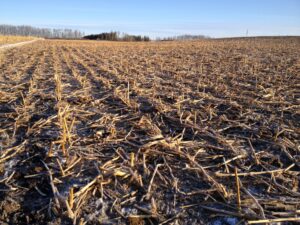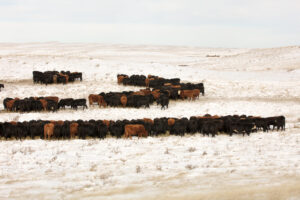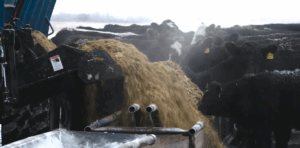Choosing the Right Winter-Feeding Strategy: Pros & Cons
Winter-feeding is one of the largest costs for cow-calf producers in Canada. How this period is managed can make a big difference in both herd health and an operation’s bottom line.
From extended grazing systems to feeding stored forages, each method has its strengths and challenges. The right strategy depends on the operation, available resources and winter conditions. Regardless of the system chosen, taking the time to test feed, balance rations and score body condition regularly will help make the most of your winter-feeding program.
Here’s a look at some common winter-feeding strategies, with the pros and cons of each and links to Beef Cattle Research Council resources where you can learn more.
Extended Grazing Systems
Letting cows graze stockpiled grasses, swaths and crop residues in the field rather than harvesting and feeding daily.

Pros:
- Lower feed, fuel and equipment costs
- Manure is deposited directly onto land, improving soil fertility
- Less daily feeding labour
cons:
- Not all regions are suited due to snow depth, timing or precipitation
- Requires planning for fencing, water access and forage allocation
- Risk of feed quality variation and potential for inadequate nutrition if not well managed
Feeding Stored Forages
Harvesting and storing forage (e.g., hay, silage, baleage, greenfeed) in summer to provide a consistent winter feed source.

Pros:
- Provides consistent feed quality if properly harvested and stored
- Flexible ration balancing to meet nutritional needs
- Less weather dependent than grazing
cons:
- Expensive to produce and store
- Spoilage losses if storage isn’t ideal
- More labour, fuel and equipment use
Bale Grazing
Placing bales out in the field for cows to feed themselves through the winter.

Pros:
- Reduces equipment and fuel costs during winter
- Manure and nutrients are distributed on the field
- Less daily feeding labour once bales are set up
cons:
- Requires upfront planning and good site selection (e.g., location, drainage, shelter)
- Risk of trampling losses if snow builds up
- May need supplementation if bale quality varies
Alternative Feeds
Using byproducts like screenings, distiller grains or canola meal to supplement rations.

Pros:
- Can lower feed costs when used strategically
- Flexibility in ration formulation
- Potential use of locally available resources
cons:
- Nutritional content varies — feed testing is essential
- Risk of anti-nutritional factors or mycotoxins
- Availability and transport can be inconsistent
Silage-Based Systems
Feeding ensiled forages (e.g., corn, haylage) as the main fiber source in the winter ration.

Pros:
- High energy, palatable feed
- Good option for high-producing or under-conditioned cows
- Consistent rations when properly ensiled
cons:
- Requires infrastructure and storage facilities
- Spoilage losses if not managed well
- Higher upfront costs than grazing systems
Key Takeaways
There’s no one-size-fits-all solution to winter-feeding. Many beef cattle producers use a combination of systems; the key is ensuring cows receive the energy and nutrition they need to maintain good body condition throughout the winter months. Feed testing, ration balancing and body condition scoring are the best tools to help keep costs in check while supporting cow health and performance.
Sharing or reprinting BCRC posts is welcome and encouraged. Please credit the Beef Cattle Research Council, provide the website address, www.BeefResearch.ca, and let us know you have chosen to share the article by emailing us at [email protected].
Your questions, comments and suggestions are welcome. Contact us directly or spark a public discussion by posting your thoughts below.